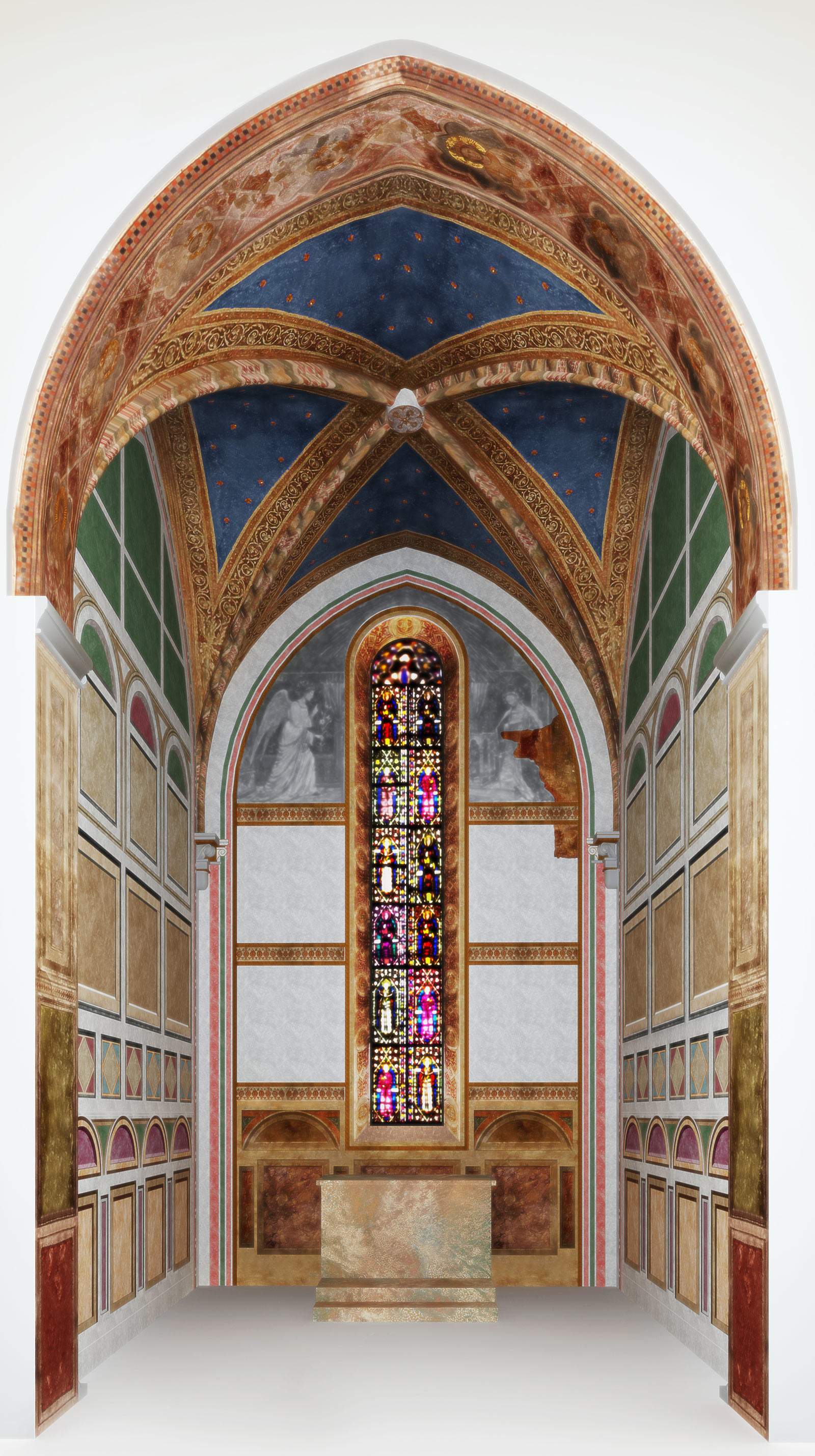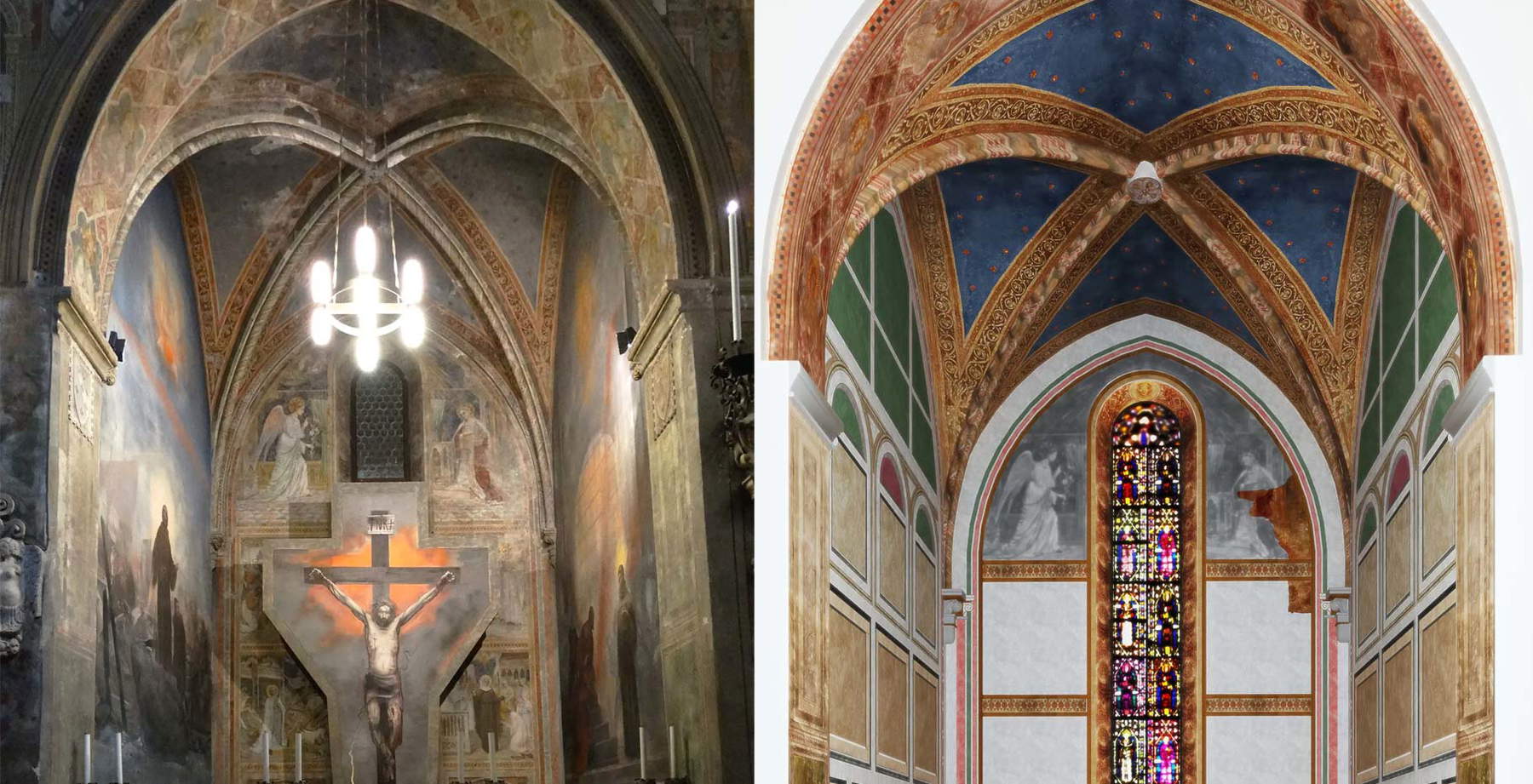Remove frescoes by Pietro Annigoni in order to bring to light older paintings executed by one of the giants of art history: Giotto. This is what is planned to be done in Padua, inside the Basilica of St. Anthony, with the aim of rediscovering the paintings that Giotto executed in the chapel of St. Catherine: the terms of Giotto’s intervention have been reconstructed by the research carried out a few years ago by art historian Giacomo Guazzini (about which we have also extensively reported on these pages). Going into more detail, the fourteenth-century decoration remained visible until 1734, when it was covered by a whitewash that left the wall empty until the twentieth century, when, between 1923 and 1925, the painter Giuseppe Cherubini was commissioned to remove the whitewash and restore what remained of Giotto’s paintings, after which, between 1981 and 1983, the room was frescoed by Annigoni with a cycle dedicated to the Stories of St. Antonino.
We do not actually know how much is given to be found under the 20th-century frescoes. However, a petition has been launched in the city calling for the removal of Annigoni’s frescoes in the event that Giotto’s can be found. The petition was launched by the local association “Orizzonti - The Future Together,” which writes on Change.org as follows: “There is a Giotto ’kept hidden’ in a symbolic site of the Urbs Picta, a World Heritage Site precisely because of its fourteenth-century frescoes. The ’concealed’ masterpieces are on the walls of the Chapel of St. Catherine at the Basilica of St. Anthony, a sort of ’mini Scrovegni’ where, according to the opinion of authoritative scholars, the artist practiced in preparation for the creation of the most famous cycles he would later produce in Assisi and Padua in the Arena Casket. Following some restoration work, Pietro Annigoni’s gigantic Crucifix dated early 1980s on the back wall and wall paintings on the side walls remain, behind which a gap separates them from the 700-year-old frescoes by the Florentine master. Horizons is promoting this signature collection to ’unveil’ the hidden Giotto.”


Few signatures are collected at the moment: just 135 in one week. However, the petition is being talked about, and the pro-removers have also garnered support from some local politicians, such as regional councilor Arturo Lorenzoni of the center-left: “According to authoritative scholars, including Padua art historian Giuliano Pisani,” he said, “Giotto practiced there before creating the celebrated fresco cycles in the Upper Basilica of St. Francis, in Assisi, and in the Scrovegni Chapel. After seven centuries, the time has come to unveil these masterpieces to give them back to the whole world. More and more Padua is Urbs Picta, a UNESCO World Heritage Site. I am grateful to Professor Pisani and the Horizons Association. They take care of our city and stimulate us to enhance every aspect of the treasures we guard.”
And again, among those in favor, the newspaper Il Gazzettino records the presence of scholar Giovanna Valenzano, professor of Medieval Art History at the University of Padua: “On the possibility of transferring Annigoni’s works, as a medieval art historian two years ago at the time of the restoration of the Santa Caterina sub-arch, I had hoped that this would happen and had also presented an outline project, which was then not materialized.” Also pro-restoration was City Council President Antonio Foresta: “I signed immediately because I think it is heresy to keep Giotto’s brushstrokes hidden, with all the respect I can have for those of Annigoni that cover them. These should be kept, but moved to another place in the Antonian complex to make visible what the Florentine master had painted, doing the dress rehearsal here in preparation for the creation of his absolute masterpiece at the Scrovegni. The Saint is visited by thousands of people and it is almost an offense not to let them see such wonders now concealed. It is time to find a solution to restore them to the world.”
Among the signatures was also that of the provincial vice-president, Daniele Canella: “I signed the petition because I believe that the possibility of recovering a part of the artistic heritage that could give further value to our city, which is already a Unesco heritage site for its fourteenth-century fresco cycles, should not be left unturned. What is underneath Annigoni are paintings made by Giotto before the Scrovegni, so a kind of ’exercise’ that absolutely goes to increase the treasures we guard in Padua, adding an opportunity in a place among the most frequented in the world by the faithful and art lovers. The Thaumaturge is one of the world’s most beloved saints, and offering people an extra opportunity to visit the complex dedicated to him could only add luster to Padua. Of course, Annigoni’s paintings, using the latest technology, must be recovered, keeping in its entirety a cultural heritage dating back to the 1980s, to which the friars are very attached. Let us resurface Giotto, however, the petition and the commitment of the institutions must be across the board to find the necessary funds for the restoration.”
Dousing enthusiasm and making things clear as they are, however, was the superintendent of Padua, Vincenzo Tinè, who cut things short, ruling out the possibility of Annigoni’s frescoes being torn off: “At that site in the 1920s the painter Cherubini had worked, who had carried out an intervention with the means of the time, pulling out what he could of the fragments of the Giottesque frescoes that he integrated with his imagination, returning an overall image that is, however, more of a twentieth-century fantasy than real. In the 1980s the commission was given to Annigoni, who re-painted from scratch the lateral parts, and so in the Chapel we now have in the sub-arch and back wall behind the Crucifix Cherubini’s work from the 1930s, and in the lateral parts Annigoni’s. Now an overall restoration of St. Catherine’s should be done, completing what was done in the sub-arch, keeping Cherubini’s layer, Annigoni’s layer and what is left of Giotto’s to highlight it, especially in the back wall, while in the sides stratigraphic surveys could be done. Annigoni, although almost fifty years old, is now historicized and is the first artistic intervention commissioned by the friars: neither he nor Cherubini can be removed.”
 |
| In Padua, they want to remove Annigoni's frescoes hoping to find Giotto |
Warning: the translation into English of the original Italian article was created using automatic tools. We undertake to review all articles, but we do not guarantee the total absence of inaccuracies in the translation due to the program. You can find the original by clicking on the ITA button. If you find any mistake,please contact us.